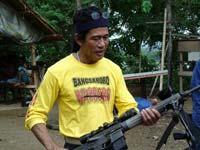Tourism derailed by terrorism

The recent abduction of two Europeans in the island-province of Tawi-Tawi in the southernmost tip of the Philippines and the continued terrorist threat in Mindanao could derail the government’s ambitious plan to make the Philippines a top tourist destination in Asia.
After a spike in tourist arrivals last year, the Philippine government is now crafting a long-range program that would make tourism a major engine in the country’s economic growth.
For the first nine months of 2011, visitor arrivals increased by 12 percent to 3.7 million, with South Korea being the country’s largest tourism market, followed by the United States, Japan, China and Australia.
Tourism Secretary Ramon Jimenez said that the Department of Tourism (DOT) is now finalizing the National Tourism Development Plan (NTDP) that aims to attract 10 million foreign visitors to the country by 2016. The DOT hopes to increase tourist arrivals this year to 4.2 million.
Last year, Malaysia had 32 million tourists while Thailand had 14 million visitors.
The abduction on Feb. 1 of Elwold Horn, a 52- year old Dutch, and Lorenzo Vinciguerra, a 47-year old Swiss, in Parangan, Panglima Sugala, Tawi-Tawi province by armed men, however, could throw a monkey wrench in the government’s grandiose tourism plans.
The two foreigners, reportedly wildlife photographers, were seized while on board a pump boat along with a certain Ivan Sarenas, a local guide, who was able to escape.
The kidnapping, which has remained unresolved four days after it happened, has prompted the British embassy in Manila to reissue a travel advisory for its citizens.
“We advise against all travel to southwest Mindanao covering the following areas: Autonomous Region in Muslim Mindanao (ARMM), which includes Lanao del Sur, Maguindanao, and the islands of Basilan, Sulu and Tawi-Tawi) plus the provinces of Sarangani, North and South Cotabato, Sultan Kudarat, Lanao del Norte, Zamboanga del Sur and Zamboanga Sibugay,” the embassy travel advisory says.
The embassy also advised against “all but essential travel to the remainder of Mindanao because of ongoing terrorist activity.” It said there have been a number of attacks against civilian targets in several areas in Mindanao since November 2011 that included at least 10 bombing incidents in North Cotabato, Cotabato City, Sulu, Sultan Kudarat, and Zamboanga killing a total of eight people and wounding of 66 others.
In 2011, some 130,000 British tourists visited the Philippines.
Aside from the Feb. 1 kidnapping of the two Europeans in Tawi- Tawi, an Australian citizen was also kidnapped in Zamboanga Sibubay on Dec. 5, 2011. On July 12, 2011 two American citizens and a Filipino were also kidnapped from a resort on the island of Tictabon near Zamboanga City.
The embassies of the United States, Australia, New Zealand and Canada have also issued similar advisories to their citizens.
Earlier, the Philippines strongly urged members of the United Nations Security Council to take a “balanced” approach in the international campaign against terrorism and called on governments to “exercise due care and diligence” in issuing travel advisories.
The call, issued during the Security Council meeting in November, said a balance must also be achieved in the issuance of travel advisories, particularly those that relate to “possible terrorist attacks.”
“While the Philippines recognized the responsibility of states to protect their citizens, Manila believed that governments must exercise due care and diligence in issuing travel advisories,” the government said.
Meanwhile, Malacanang, the seat of the Philippine government, has tried to reassure foreign embassies on the latest kidnapping incident.
“We condemn the abduction, and the national and local governments, as well as all agencies concerned, are working to ensure the resolution of the situation, the recovery and release of the men who remain in the hands of their captors, and the bringing to justice of the lawless elements involved,” Deputy Presidential Spokesperson Abigail Valte said.
Valte urged foreign tourists to check with the Department of Foreign Affairs, as well as their own embassies, regarding advisories on conditions that may affect their travel and other arrangements while visiting the Philippines.
The military has suspected rogue members of the Moro National Liberation Front (MNLF) to be behind the abduction of the two European tourists.
“There was information that rogue elements of the MNLF were involved. But we are verifying the reports,” said Armed Forces chief of staff Jessie Dellosa.
Dellosa said government troops and the police have intensified the pursuit operation to locate the victims and their abductors in an area of Tawi-Tawi.
But Dellosa also cited the possibility that the kidnappers might have escaped to nearby Sulu province where military forces have launched intensified operations following the air strike that reportedly killed 15 top-ranking Islamic terrorists with links to Al Qaeda and Jemaah Islamiyah (JI).
According to the military, among those killed in the air strike in Parang, Sulu last month were three of the most wanted terrorist leaders: Malaysian Zulfikli bin Hir, also known as Marwan, a top JI leader; Abu Sayyaf leader Umbra Jumdail alias Doc Abu; and Singaporean JI leader Abdullah Ali alias Mauwiya.
Leave a comment






